Coin Rarities & Related Topics: News and Analysis regarding scarce coins, markets, and coin collecting #358
A Weekly CoinWeek Column by Greg Reynolds …..
This discussion is about those U.S. half cents that are or were worth more than $1 million each, or may realistically retail for that much in the near future. As markets for the best half cents have been volatile, it is particularly difficult to estimate their current market values. In all eras, half cents have been intriguing and entertaining coins that have not received nearly as much publicity as large cents, half dollars, silver dollars or double eagles.
* * *
A majority of the 20 most valuable half cents have recently spirited into the limelight after being in the shadows for many years. In January 2014, the Goldbergs, in association with Chris McCawley and Bob Grellman, auctioned the all-time greatest set of half cents, the Tettenhorst-Missouri Collection. I then provided extensive coverage of this collection.
In February 2016, the 18th-century half cents of the Pogue set were auctioned by Stack’s-Bowers, in association with Sotheby’s. This group included a few that the Pogues had acquired at the Tettenhorst-Missouri sale on January 26, 2014. It also included early half cents that had not traded publicly for a long time.
1) Weinberg-Tettenhorst-Pogue 1794 Half Cent
A key issue regarding 1794 half cents is whether 1794 half cent are classified as a separate design type distinct from the half cents of 1795 to 1797. Half cents were first struck in 1793, and 1793 half cents clearly constitute a one-year type.
On 1793 half cents, the head of Miss Liberty faces to the left, from an observer’s perspective. On half cents dating from 1794 to 1797, the head of Miss Liberty faces to the right. The artistic workmanship of the head on 1794 half cents, however, is notably different from that of the head of 1795 to ’97. Are the differences so significant that 1794 half cents constitute a one-year design type?
This question is complicated by the fact that a major variety of 1794 half cents features a head of Miss Liberty in relatively high relief. If a collector concludes that a 1794 half cent and a half cent dating from 1795 to 1797 are both required for a type set, it would be logical to seek a 1794 that is in relatively high relief for a type set, as these further distinguish themselves from 1793 half cents and those dating form 1795 to ’97.
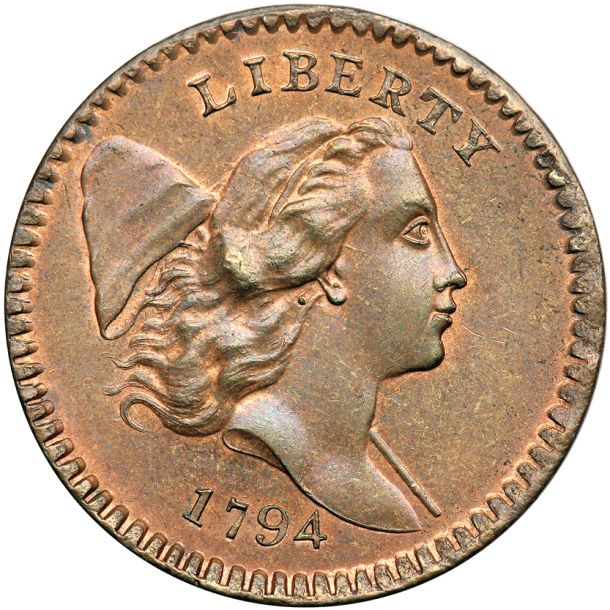
Coins struck from the die pairings referenced as Cohen-7, -8 and -9 are all relatively high relief 1794 half cents. A standard book about die varieties of half cents was written by Roger Cohen, long ago.
The auction record for all half cents is held by a 1794 that was struck from the die pairing known as Cohen-7, though it would be just as valuable if it were struck from the Cohen-8 or -9 die pairings. The high-relief aspect and, more importantly, the concept that 1794 is a one-year design type contribute to this coin’s value. Additionally, and in the opinions of many, the Weinberg-Tettenhorst-Pogue 1794 is the finest known of all surviving 18th-century U.S. half cents of any date.
I devoted a whole article to this coin, which was published on January 23, 2014, and mentioned it again in a review of the Pogue III sale. It would not be efficient to detail its physical characteristics here. The Weinberg-Tettenhorst-Pogue 1794 was PCGS-graded MS-67 with a designation that it has substantial original mint red color (“RB”), and it was approved at CAC. It certainly has much mint red, an incredible amount for an early copper coin.
On January 26, 2014, this 1794 realized $1,150,000. About two years later, on February 9, 2016, this same coin brought $940,000 USD in the Pogue III event. Though not weak, the $940,000 result was less of a retail price than the price realized in 2014. The Pogue III event did not fare as well as the Pogue II or Pogue IV auctions. It is fair to figure that this coin has a current retail value above $1 million now? I believe so.
Jim McGuigan maintains that the Eliasberg-Pogue 1796 ‘No Pole’ coin is the most valuable half cent. I contend that this Weinberg-Tettenhorst-Pogue 1794 is the most valuable, partly because of demand by type collectors and partly because I find it to be the most amazing of all 18th-century half cents.
2) Blay 1796 ‘With Pole’ Half Cent
The sleeper among half cents is Blay’s 1796. He is a long-time collector who is widely known as a connoisseur of copper coins, especially of bronze cents. Blay prefers that his first name and the city in which he resides not be mentioned at this time.
Blay acquired this coin during the 1990s. Certainly, it was PCGS-certified as ‘MS-66RB’ long before it was publicly displayed at the ANA Convention in 2008. More recently, it has been assigned a ‘+’ grade and images of it may be viewed on the PCGS CoinFacts site.
The Blay 1796 ‘With Pole’ half cent has never been auctioned by Stack’s and/or Bowers, ANR, the Goldbergs, or Heritage. Jim McGuigan remarks that “it is at least 60% mint red” and would “probably” retail for “more than $1 million” if offered privately in the present.
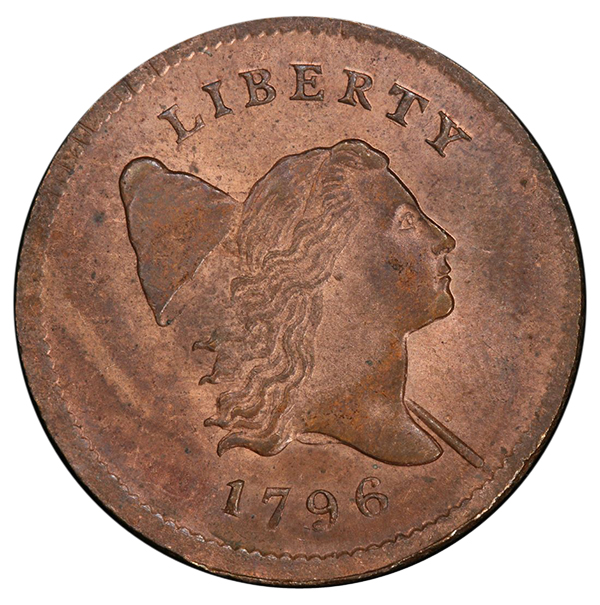
I figure its current retail value in the range of $825,000 to $1.1 million. Market values for gem early half cents could move markedly, in either direction, over the next year. Prices for gem-quality half cents have recently been less stable than those for commensurable coins of other types.
Although the 1796 ‘With Pole’ is not nearly as rare as the 1796 ‘No Pole,’ it is much rarer than all 1794 half cents. A past article of mine covers 1796 half cents, including references to the origins and meaning of ‘the pole’.
Jim McGuigan figures that there are “around 125” 1796 ‘With Pole’ half cents in existence. He emphasizes that “maybe 90 of these grade less than VG-10.” For decades, McGuigan has been a leading expert in half cents. He responded to my inquiries earlier this week.
The Tettenhorst-Missouri 1796 ‘With Pole’ was PCGS-certified as ‘MS-65+ Red & Brown’ and CAC-approved in 2013. As I said in the past, there is some rather bright, original mint red on that coin, especially about the design elements. The color on the obverse is much more impressive than the Tettenhorst-Missouri catalogue’s description suggests. The $718,750 result on January 26, 2014, was surprisingly weak in an auction where 19th-century half cents brought very strong prices (a few of which were incredibly high). No one then knew that the Pogue Family Collection would soon be auctioned.
If my memory from 2008 is accurate, it is likely that the Blay 1796 ‘With Pole’ half cent would be CAC-approved if submitted. I am not, though, guaranteeing or even predicting such an event. The Reale-Whitney-Pogue 1796 ‘With Pole’ is not CAC-approved. Almost all of the coins in the first four Pogue sales were sent to CAC.
The Reale-Whitney-Pogue 1796 is PCGS-certified as ‘MS-66RB,’ though some interested bidders did not agree with this grade. Furthermore, it has significant technical issues that are readily noticeable. This coin had been certified with a grade lower than 66 in the past. Nonetheless, it is a very attractive coin with considerable, true original mint red, certainly an appealing coin.
The price realized for the Reale-Whitney-Pogue 1796 ‘With Pole’ on February 9, 2016, was low, $470,000. The “Blay and Tettenhorst-Missouri 1796 ‘With Pole’ half cents are more desirable than the Reale-Pogue coin,” Jim McGuigan remarks.
Decreases in market levels and the mood at the Pogue III auction, especially as contrasted with the crazed bidding and euphoria at the Pogue II event, were factors. Even after incorporating these points into an analysis of the $470,000 auction result for the Reale-Whitney-Pogue coin, an inescapable conclusion by those who have carefully examined the leading 1796 ‘With Pole’ half cents is that the Reale-Pogue coin did not bring a price commensurate with its rarity, rich color and certified grade because interested bidders were not completely accepting of the ‘MS-66RB’ assignment.
Another important coin of the 1795-97 design type is the Bushnell-Foxfire-Pogue 1797 that is PCGS-certified as ‘MS-66RB’ and CAC-approved. It is of significantly higher quality than the just mentioned Reale-Pogue 1796 ‘With Pole.’ The Bushnell-Foxfire-Pogue 1797, however, is not rare, as a date or as a representative of a specific die pairing.
Although the Foxfire-Pogue 1797 is an exceptional coin, the Blay 1796 is superior in quality and in rarity. Besides, with and without poles, 1796 half cents are the keys to sets of 18th-century half cents, and have been very famous among collectors for more than a century.
3) The Eliasberg-Pogue ‘No Pole’ 1796
There are certainly fewer than 40 1796 ‘No Pole half cents in existence, probably fewer than 30. These are thus extremely rare in all grades.
In May 1996, an auction record for any kind of copper coin was set when the Eliasberg 1796 ‘No Pole’ brought $506,000. This record was not broken until 2008, and a half cent was not auctioned for more until the Tettenhorst-Missouri sale on January 26, 2014.
The Eliasberg 1796 ‘No Pole’ was PCGS-certified as ‘MS-67RB’ after it was auctioned in 1996. The enthusiasm and awe regarding this coin were understandable. I was one of many captivated by it during lot viewing sessions. Nevertheless, coin enthusiasts and wholesalers whom I knew then were valuing it as a MS-65 grade coin. The ‘MS-67RB’ grade assignment at PCGS surprised us all, since there are a couple of very noticeable scratches on the obverse.
The raw Whitney 1796 ‘No Pole’ sold for $287,500 on May 4, 1999, during a time when prices for rarities were fractions of current prices. In terms of quality, it is not in the same league as the Tettenhorst or Pogue pieces, if I remember the Whitney piece accurately.
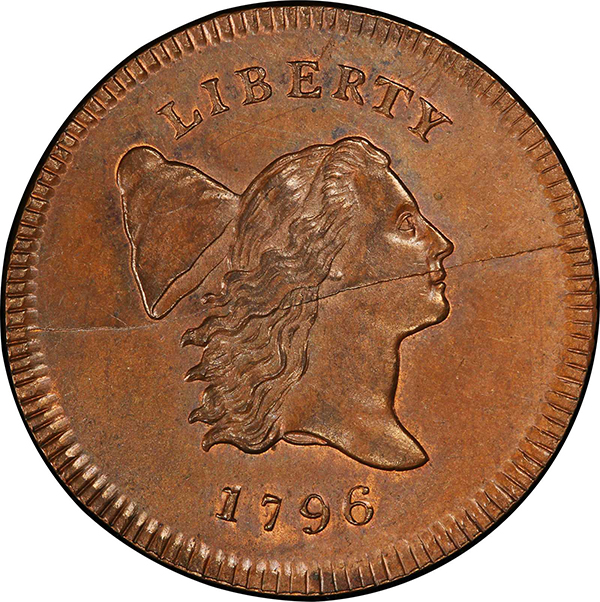
I attended the sale of the Ray Rouse Collection of half cents on September 15, 2008. It was conducted by the Goldbergs, along with McCawley & Grellman, in Los Angeles. The Rouse 1796 ‘No Pole’ half cent grades VF-20, more or less. In 2008, I figured that it was the fifth or sixth finest known.
The Rouse coin then brought $345,000. The Eliasberg-Pogue, Tettenhorst and Whitney pieces are very much superior to the Rouse piece and were held then to each be worth multiples of the value of the Rouse piece.
At that auction in September 2008, Chris McCawley and I discussed the value then of the Eliasberg 1796 ‘No Pole’ half cent.
Markets for rare U.S. coins on the whole peaked in the middle of 2008. All the half cents mentioned in this discussion were worth more in July or August 2008 than they are in the present.
For educational purposes, McCawley and I imagined that the Eliasberg coin was sold the same day that Ray Rouse’s half cents were auctioned. This was a hypothetical construct, as the Eliasberg 1796 was not auctioned in reality between May 1996 and February 2016. McCawley said that it would have brought “more than one million” on September 15, 2008. I was then thinking of a range from $1.1 to $1.4 million, with $1.25 million being a moderate value. I did not, though, see the Eliasberg-Pogue 1796 ‘No Pole’ half cent between 1996 and 2016.
In 2011, in the revised listing of the PCGS “million dollar club” project, this was the only half cent valued above $1 million. Experts at PCGS then valued the Eliasberg-Pogue 1796 ‘No Pole’ at “$1,750,000”. In my view, it might have been worth that much in July or early August 2008, but not in 2011.
I would swear that this coin had more original mint red in 1996 than it did in 2016. I carefully examined it in 1996 and in 2016, and wrote notes. It is not unusual for original mint red copper color to fade or tone over time, especially on a coin from 1796! It is less than 15% red now, in my estimation.
Nevertheless, Jim McGuigan regards the Eliasberg-Pogue ‘No Pole’ as the most valuable half cent. He was expecting a million dollar result in 2016. It is relevant that the PCGS-certified ‘MS-65-Brown’ Tettenhorst-Missouri 1796 ‘No Pole’ brought $891,250 on January 26, 2014.
In McGuigan’s view, the Eliasberg-Pogue 1796 ‘No Pole’ half cent is “considerably more eye appealing” than the Tettenhorst-Missouri 1796 ‘No Pole’ half cent. For half cent collectors, the 1796 ‘No Pole’ is the queen. These are likely to be the two best.
4) The Tettenhorst-Pogue 1811
The Tettenhorst-Pogue 1811 is PCGS-certified as ‘MS-66RB’ and has a sticker of approval from CAC. The 1811 is an amazing condition rarity in ‘mint state’ grades.
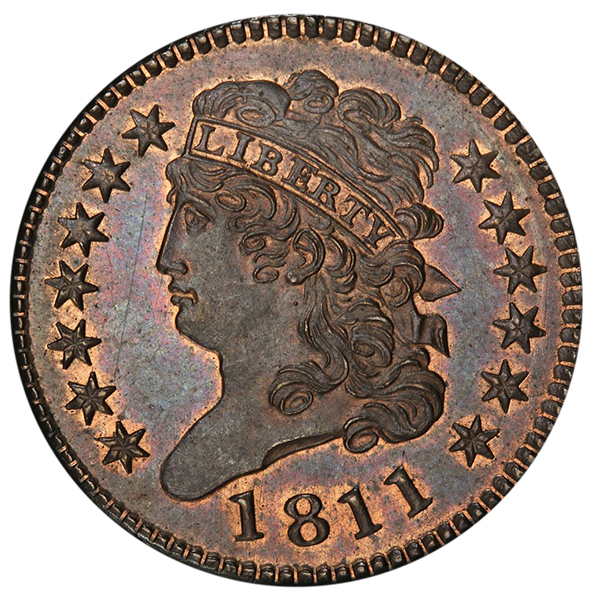
Another Tettenhorst 1811, of a different die pairing (C-2), is PCGS-certified as “MS-65+BN” and CAC-approved. This second Tettenhorst 1811 realized $299,000, a noteworthy price. Had the PCGS-certified ‘MS-66RB’ half cent not been in the same auction, this $299,000 result would have been an extremely strong price and a newsworthy event.
The Tettenhorst-Pogue 1811 brought $1,121,250 on January 26, 2014, an auction record for any 19th century half cent. “[That] price in 2014 was extremely strong. I did not think of it as a million dollar coin,” McGuigan relates.
Concluding Thoughts
“In my mind,” Jim McGuigan says, the “Eliasberg-Pogue 1796 ‘No Pole’ and the Blay 1796 ‘With Pole’ are worth more than any 1794 half cents. Traditionally, 1796 has been recognized as the key date for half cents. The best 1796 half cents are the million dollar half cents.”
It is true that there are likely to be fewer than 150 1796 half cents overall, including ‘With Pole’ and ‘No Pole’ coins. There are, though, collectors assembling gem quality type sets to the extent that such a quest is viable. They are not as enthused about 1796 half cents.
The Weinberg-Tettenhorst-Pogue, PCGS-graded MS-67RB 1794 is just so incredible. I would rather own it than any of the 1796 ‘No Pole’ half cents. The Blay 1796 ‘With Pole’ is not quite as exciting as the just mentioned 1794. It is, though, incredibly original and technically amazing, in addition to being the finest of a rarity.
As for the two PCGS-certified “MS-66BN” 1793 half cents, these are neat, but there are appealing PCGS-graded MS-65 1793 half cents, too, at least one of which has some original mint red. While two or three 1793 half cents could be million dollar coins in the future, the Weinberg-Tettenhorst 1794 and Blay 1796 ‘With Pole’ coins are million dollar coins in the present. The values of the Eliasberg-Pogue and Tettenhorst 1796 ‘No Pole’ coins, and the Tettenhorst 1796 ‘With Pole’ half cent, are harder to grasp.
© 2016 Greg Reynolds
* * *
Recent Articles in This Series on Million Dollar Coins:


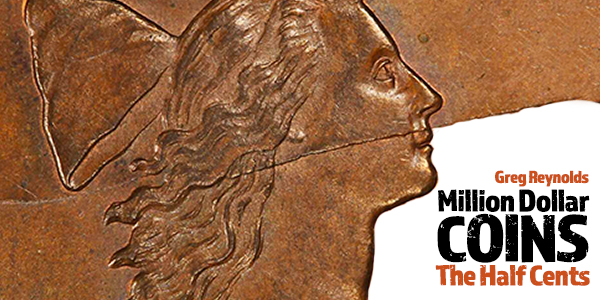



Its amazing these coins don’t get more publicity , imagine a half cent selling for over a million dollars ! Bravo Mr. Reynolds !! Great story !